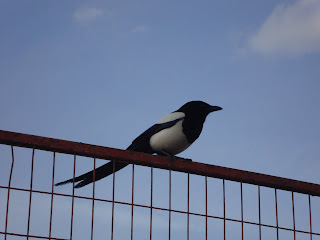The northern flicker, Colaptes auratus, is a member of the woodpecker family, Picidae. Furthermore, this flicker is a migratory bird which can be found it in parks and open woodlands of North and Central America. In addition, this flicker is going to peck or "hammer" on dead tree limbs during courtship. However, both sexes help to excavate their own nest in trees, telephone poles, cactus, etc.
El carpintero escapulario, Colaptes auratus, es un miembro de la familia de los pájaros carpinteros, Picidae. Es un pájaro migratorio, el cual puede ser encontrado en bosques y parques de la parte norte y central de América. Además, durante la época de cortejo se le va a escuchar martillando los arboles, postes telefónicos, cactus, etc, donde ambos sexos van a excavar su nido.
The Northern flicker is omnivorous and opportunistic, and it eats mainly insects, but also seeds, fruits and berries.
Este pájaro carpintero es omnívoro y oportunista, y se alimenta principalmente de insectos, pero también de semillas y frutos.
 |
| Eating / Comiendo |
There are several subspecies, and the Red-shafted Northern Flicker, Colaptes auratus cefer, is found in Alberta. The male has strong bill for drilling holes, black spots, red wings linings, red moustache, a black crescent on the breast, and long sticky tongues for extracting insects. Furthermore, the female is similar to male, but lacks moustache.
Hay varias subespecies de carpintero, y en Alberta podemos encontrar la subespecie Colaptes auratus cefer. El macho y la hembra son similares. Ambos tienen lunares negros, una marca negra en la parte superior del pecho, la parte interior de las alas es de color rojizo, un pico fuerte y largo para poder martillar los arboles, y una lengua larga y pegajosa para extraer insectos. Y la única diferencia entre ambos es que el macho se caracteriza por tener un bigote de color rojo, mientras que la hembra carece de ello.
 |
| Male / Macho |
I hope you like it!



































